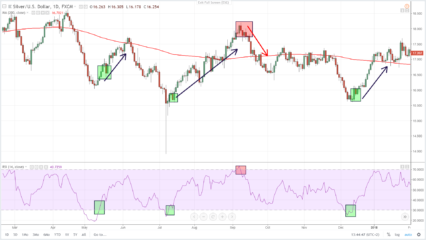To measure oversold and overbought, we use the technical oscillator RSI (Relative Strength Index), which is translated as the Index of the Relative Strenhgt. In our example, we will use silver, because this precious metal is characterized by good and long trends that can be traded nicely. We set the RSI oscillator to parameter 14, ie to a medium-fast base, in order to filter out as many false signals as possible.
We will use a daily chart for trading so that we can capture larger movements in this currency pair.
We will enter long positions (ie buy) when the RSI curve gets from values below 30 back above 30. This may signal that the market is oversold and is ripe for an upward correction, as investors are likely to close short positions and the market as a result, purchases will occur that could push the price of the instrument up.
As we can see in the chart, we would record three buying positions, all of which would end up in profit as the market picked upwards (bullish trend).
Otherwise, we would start selling (ie short-circuiting) when the RSI curve gets back from above 70 to below 70. This may signal that the market is overbought and is ripe for a downward correction, as investors are likely to close long positions and sales that could push the price down will therefore hit the market.
As we can see in the chart, we would only realize one sales position, but it would also end up in profit, because the market has gone downwards.
Since it is a more volatile instrument, it is necessary to choose a larger stop loss, e.g. 30 cents, while the withdrawal of profit should be made at 60 cents, or if the position is in profit, slowly shift the Stop loss and do not use the Take profit order. In the case of greater movement, the potential for profit is much greater.
However, it should be kept mind that even this strategy is not infallible and in some cases may not work, especially if the market moves sideways in a long time-frame.
This strategy is suitable for advanced traders.




